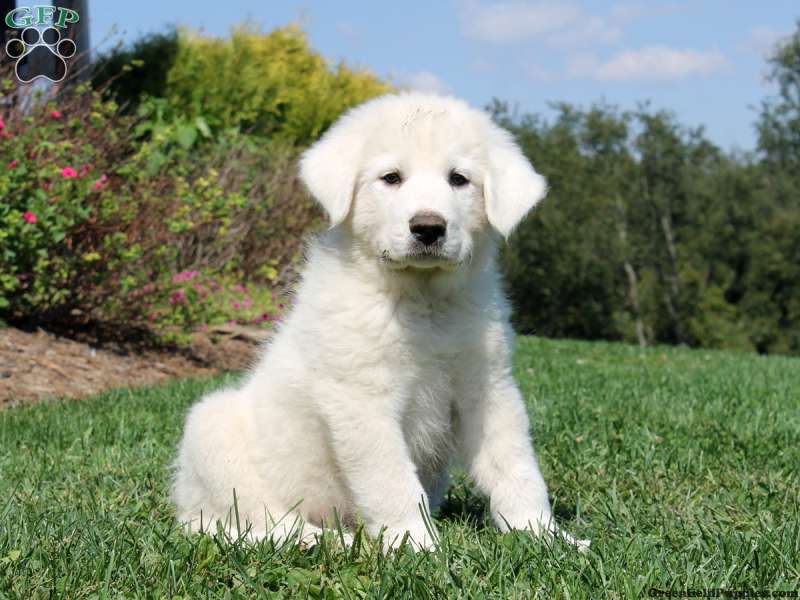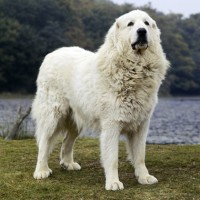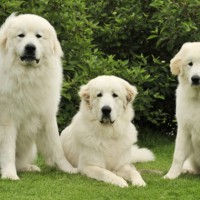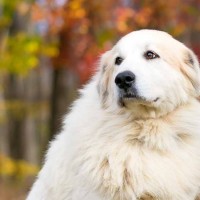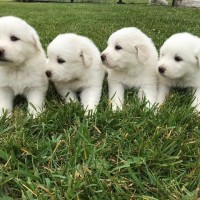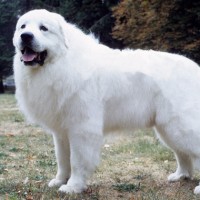Breed information
Group:
Working
Life span: 10-12 years
Height male: 69-81 cm/ 27-32 inches
Height female: 63-74 cm/ 25-29 inches
Weight male: from 45 kg/ 100 pounds
Weight female: from 38 kg/ 85 pounds
Character: Affectionate, Confident, Fearless, Gentle, Patient, Strong Willed
History
The Great Pyrenees is a very old breed that has been used for hundreds of years by shepherds, including those of the Basque people, who inhabit parts of the region in and around the Pyrenees Mountains of southern France and northern Spain (specifically Aragon and Navarre).
Varro, a Roman author who lived in the first century BC, wrote in his treatise of rural economy "De re rustica" in 37 BC.:
"The dog is essential for those who raise animals for wool. It is the guardian of livestock in general but is the natural defender of the sheep and goats. The wolf lurks constantly and we oppose it with the dogs"... "As for its appearance, choose those who are well-trained, large size, with black or red eyes, the nose of the same color, red lips pulling to black, not too collected, nor too pendants"... "It is equally essential that the dogs have strong head, long, floppy ears, wide and short neck, thighs and rights more inwardly turned than out, wide legs, fingers apart, hard nails and bent, spine nor projection nor convex, bushy tail, sonorous voice, good match muzzle and preferably with white hair so that it can be easily distinguished from wild animals at night."
One of the first descriptions of the breed dates from 1407, Fray Miguel Agustín, "prior" of the Temple who lived between 1560 and 1630, published in 1617 in Catalan (the first edition appeared in Spanish in 1622), a book which he called Libro de los secretos de la agricultura, casa de campo y pastoril. It gives the reasons why shepherds prefer white puppies, excluding those born with spots of dark color. Relates the friar: "The wool cattle dogs should not must be so big or so heavy as those of the guard of the house, but strong and sturdy, lightweight and ready to combat and fight and for run, because they have to make saves and guard against wolves and hunt them down if those take a cattle... These should be white so that the shepherd can easily see when these run after the wolf and know them in the evening and the morning." From 1675 the breed was a favorite of The Grand Dauphin and other members of the French aristocracy. In the mid-19th century, the breed was not homogenized.
Description
The Great Pyrenees dog conveys the distinct impression of elegance and unsurpassed beauty combined with great overall size and majesty. He has a white or principally white coat that may contain markings of badger, gray, or varying shades of tan. He possesses a keen intelligence and a kindly, while regal, expression. Exhibiting a unique elegance of bearing and movement, his soundness and coordination show unmistakably the purpose for which he has been bred, the strenuous work of guarding the flocks in all kinds of weather on the steep mountain slopes of the Pyrenees.
Health
The average life span of the Great Pyrenees is 10 to 12 years. Breed health concerns may include bloat (gastric dilatation and volvulus), tricuspid valve dysplasia, degenerative myelopathy, congenital deafness, elbow and hip dysplasia, shoulder osteochondrosis, factor XI deficiency, osteosarcoma, entropion, ectropion, progressive retinal atrophy and assorted skin problems.
Personality
Great Pyrenees are have been described as regal dogs. They are thoughtful animals, very observant and vigilant. Their original purpose was to guard flocks and they were charged with making independent decisions about who was a friend and who was potentially dangerous. The modern Pyrenees takes his watchdog role seriously, quietly sizing up newcomers before making a decision. They are fiercely protective of their property, family, and even other household pets. Pyrenees are patient and gentle with kids in their own family, but often don't take kindly to outside children engaging in rough play with their charges. These gentle giants love to play, and their favorite time to romp and play is after a good snow. Giving them a job to do after a snowstorm, like pulling kids in a sled or hitching the Pyrenees to a cart will keep him occupied for hours.
Activity Requirements
Great Pyrenees are large dogs that are completely unsuitable for apartment life. They require a lot of space, both indoors and out. However, exercising a Great Pyrenees can be a delicate balance. They can easily overheat, especially in summer so exercise should be kept to a minimum in warm months. This, of course can lead to pent up energy, so it can seem as if the Great Pyrenees is stuck in eternal puppyhood, bouncing around and often chewing everything in site. Taking them on regular walks and adjusting the length and speed based on the time of year is the best way to exercise the Pyrenees. Romping in the yard is fine, too. He will give cues when he has had enough exercise.
Trainability
Great Pyrenees don't like to be told what to do. They were designed to be independent thinkers, capable of making their own decisions and training can be a challenge, even for experienced dog owners. Consistency and strong leadership are the keys to making a training program work. Positive reinforcement with lots of delicious treats can motivate the Pyrenees to listen. Discipline and harsh tones will get the opposite response the trainer is looking for. Socialization is very important with this breed. They need to learn early on what the behavior of a welcome guest looks and feels like, so that they are capable of knowing the difference between the “good guys” and any potential “bad guys.” If not taught to properly recognize welcome visitors, Pyrenees can assume all guests are intruders.
Best Training Equipment Trainers Recommend
Behavioral Traits
Because the Pyrenees were bred to drive away predator like wolves, they can be aggressive toward other dogs, especially males. They do just fine with dogs of the opposite sex and can easily be raised in multiple-dog homes, but new dogs should be introduced carefully and they may not ever accept visiting dogs. Their aggression is difficult to train out of them, and even well-socialized Pyrenees can sometimes turn dog aggressive seemingly out of nowhere, but this is simply their nature.
This breed has a reputation for household destruction. As puppies they are chewers and it can take a long time to teach a Pyrenees the difference between a chew toy and your favorite recliner. This habit can be a hard one to break, especially if owners work long hours. Great Pyrenees are best suited for farm life, where they can be “at work” guarding animals during the day, or in families where there is a stay at home parent. Even the most well behaved Pyrenees may not be able to help himself from chewing while he is left to his own devices. This vigilant watchdog can drive neighbors crazy with their barking. They will sound the alarm when people come near his home, and tend to bark the most at night. Socialization, training to obey commands to cease barking can help, but it's difficult to train this behavioral out of the Pyrenees.
Shedding
The thick coat of the Great Pyrenees may look high-maintenance, but is actually easy to care for, when the dog is a family dog only. Show grooming is time consuming and a breeder can teach the proper technique for show grooming a Pyrenees. The coat is naturally water and dirt resistant, so only bathe the dog as needed. Brush the dog every two or three days to remove loose and dead hair – but over-brushing can actually break off the ends of the hair. The Great Pyrenees varies as far as shedding. Some dogs shed once a year, while others seem to drop hair all year long. Warm baths can help release shedding hair. Check the dog's ears on a regular basis for signs of irritation, infection, or wax buildup. Cleanse with a cotton ball and a veterinarian-approved cleanser. Brush the teeth every week to remove tartar buildup and keep breath fresh. If the dog does not wear down his nails naturally, trim them monthly.
